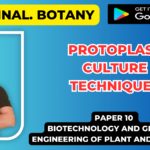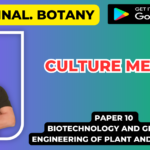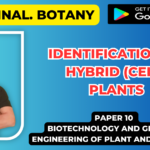![]()
Basic Aspects of Plant Tissue culture
Plant tissue culture laboratory
The plant tissue culture laboratory should have basic facilities that include washing and storage facilities, media preparation sterilization and storage area, transfer area for aseptic manipulations culture room and data collection area.
1. Washing and storage facilities: –
- The main requirement for washing is provision for water and sinks and access to deionised, distilled and double distilled water apparatus.
- Space for ovens, plastic or steel buckets for shocking labware acid or detergent baths driers and cleaning brushes, washing area may be provided with dust proof cupboard and storage cabinets.
- The disposal of wastes should be proper to minimize health risks and environmental hazards.
- Maximum cleanliness must be observed in tissue culture laboratories to avoid contamination.
- The glass wares used in tissue culture labs should be resistant to heat.
- Generally good quality Borosilicate glass is recommended. The conventional method of cleaning glassware is to soak for 4 hour sodium dichromate, Sulphuric acid bath and then vigorous washing under tap water.
- Due to the corrosive nature of acid detergents are used for washing followed by rinsing in tap water, followed by second rinse in deionized water and final rinse in distilled water.
- To dry the cleaned glassware it is placed in an oven at high temperature or air dried.
- Washed and dried labware is finally stored in the cupboard to avoid dust.
2. Media preparation room-
The media preparation room should have the following basic requisites.
- Hot plates or stirrers
- pH meter
- Digital balance
- Water bath
- Oven
- Autoclave
- Culture vessels.
Other requirements include vacuum sources, refrigerator freezers for safe storage of chemicals and media.
Sterilization
Sterilization is the killing or removal of all microorganisms to prevent growth of bacteria or fungi in the culture flasks containing nutrient medium and plant tissues.
In PTC the media are sterilized using autoclave the glasswares are sterilized and dried in electric oven before use and flame and chemicals are used before transfer.
Sterilization can be done by mainly three methods.
- Physical Agent
- Chemical Agent
- Radiation
Physical sterilization can be done using heat which is further subdivided into-
Sterilization by dry heat
Dry heat sterilization with the use of electric oven can be used to sterilize glassware like petri plate, flask, pipettes, culture tube, etc at 160 – 180⁰C. This temperature is required to kill the most resistant spores of bacteria and other microorganism.
Sterilization by wet heat
In this method sterilization is done by steam under pressure and is done by the use of an instrument called autoclave. The media and culture tube to be autoclaved are placed in the inner jaket of the autoclave. The autoclave is closed air tight and water in it starts boiling. The inside pressure increases. The water boils and reaches at 121⁰C. At 15lb pressure per square inch this is maintained for 15 minutes to kill all the resistant spores.
Sterilization by red heat –
foreceps , loop and inoculating needles in the transfer chamber are sterilized in flame by making them red hot followed by cooling them before transfer. Red hot makes them sterilized.
II Chemicals
- Detergents-Detergents are surface active agent and can be anionic or cationic. They are used in plant tissue culture laboratory for cleaning and sterilizing glasswares.
- Sodium dichromate sulphuric acid bath is also used to soak and sterilizing glasswares.
- Ethyle alcohal 70% solution is used for wiping the walls and work bench of Laminar Air Flow Bench, forceps inoculationg loops, needles scissors etc.
- Mercuric chloride -0.1 – 1.0% solution of mercuric chloride is used to disinfect plant material (explant) This chemical is highly poisonous and should be handled with extreme care.
- Gaseous sterilization – The chemically ractive gases such as formaldehyde and ethylene oxide possess biocidal activity. Both these gases can be used to sterilize PTC laboratories but they are potentially mutagenic and carcinogenic.
III. Radiation
Radiation sterilization with ultraviolet rays is usually performed in laminar Air flow bench before aseptic transfer. For this the U.V. Ray are used for 30 Minute before using the LAF.
3. Transfer area-
LAF is the most suitable for tranfering. The LAF cabinate consists of workbench, with HEPA filter, moter, UV light flurocent light. The motor blow air into the unit first through a coarse filter and then throgh a 0.3mHEPA filter. The unit is called verical flow if the air is directed downward or called horizontal flow unit if the air is directed outward over the working sufrace, The air coming out of the fine filter is ultraclean free from bacterial or fungal contaminants and its velocity is 27 3 m/min. In this way an aseptic environment is maintained as long as the cabinate is swithced on.
4. Culture room –
All types of plant tissues are incubated under conditions of well controlled temperature humidity illumination and air circulation.
A typical culture room should have both light and temperature programmable for 24 hrs.
Air conditioners and heaters are used to maintain temperature around 252Cin the plant tissue culture racks. Each rack is provided with separate set of fluorescent lights. Insulation between the lams and shelves above ensures a more even temperature around the culture. Individual shelves may also be ventilated by a small fan at one end of the shelf and thus prevent build up of hot air in the shelves due to lamps.
The culture room should have a humidity range from 20-98% controllable to 3% and uniform forced air ventilation.
Lighting is adjusted in terms of quality and quantity. Cultures are generally grown in diffused light less than 1 kilolux, but provisions for maintaining cultures in higher light intensity as well as total darkness should also be made.
The culture vessels can be placed directly on the shelves of tissue culture racks having a label giving details of the experiment including name of the plant explant medium date of culture etc.
5. Data Collection area-
The growth and development of tissues cultured in vitro are monitored by observing cultures at regular intervals in the culture room. Data based on the observations may be collected under aseptic conditions using a LAF cabinet.
Microscopic examination of culture tissue can be performed. According to engelman (1994) for germplasm conservation it is essential to have lower temperature rooms and installation of cryopreservation units is a must.
6. Transplantation area-
Plants regenerated from in vitro tissue culture are transplanted to soil in pots. The potted plants are transferred to green houses and maintained for further observations under controlled conditions of light, temperature and humidity. This is called hardening or acclimatization.













